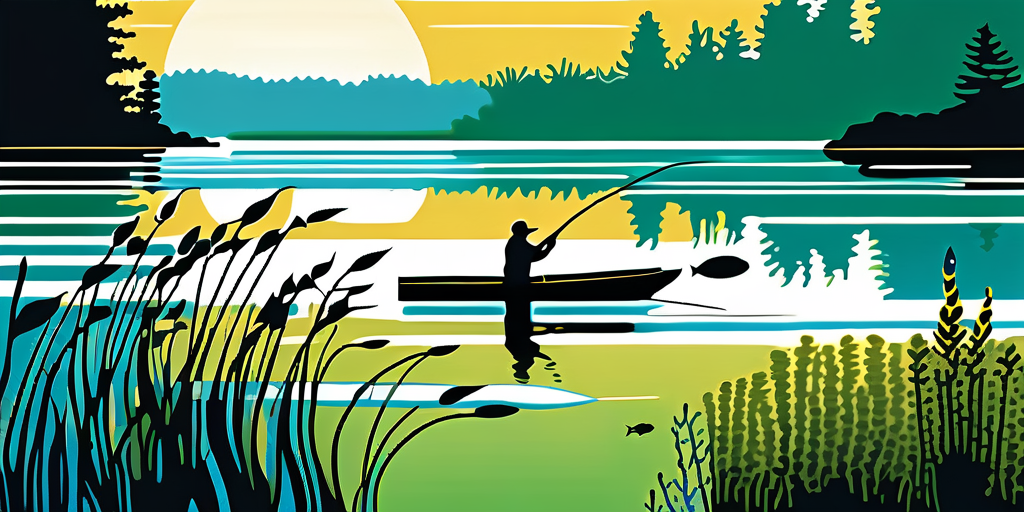
Fishing is more than just a hobby; it’s an adventure that can transform a quiet day on the water into an exhilarating experience. For avid anglers, catching a trophy fish is akin to striking gold. Watts Bar Lake, with its stunning landscapes and rich ecosystem, offers some of the most rewarding trophy fishing opportunities. In this article, we’ll explore the allure of trophy fishing, the diverse bounty of Watts Bar Lake, essential gear for success, effective fishing techniques, and how to preserve and display your prized catch.
Trophy fishing is a pursuit that draws many to the water's edge with a sense of anticipation and excitement. The thrill of landing a fish that surpasses the average size not only boosts one's ego but is also a testament to patience, skill, and a deep connection with nature.

There’s nothing quite like the adrenaline rush experienced when a fish hits your line. The moment when the rod bends and the reel starts spinning is electrifying. The struggle that follows, pitting angler against fish, showcases the unpredictable nature of fishing and highlights the joy of conquering the element of surprise.
Every trophy fish has its own personality and fighting style. Some species leap out of the water in acrobatic displays, while others dive deep, testing the limits of your gear. The thrill isn’t just in the catch, but in the chase itself—a story woven from the moments spent waiting and hoping on the water. Each cast is a new opportunity, and the anticipation builds with every ripple on the surface, as you envision the potential of what might be lurking below. The camaraderie among fellow anglers adds to the experience, as shared tales of near-misses and triumphant catches create a rich tapestry of fishing lore that bonds participants together.
In addition to sheer thrill, trophy fishing is a true reflection of angling skill. It requires an understanding of various fish species, their behaviors, and the intricacies of their habitat. Anglers invest time and effort into honing their techniques, whether that involves selecting proper bait or mastering casting methods.
The satisfaction of catching a trophy fish stems from putting all those skills to the test. As you perfect these methods, your confidence grows, leading to even greater achievements on the water. Moreover, the learning curve is steep; each outing presents new challenges, whether it’s adapting to changing weather conditions or deciphering the subtle signs of fish activity. This constant evolution not only sharpens your abilities but also deepens your appreciation for the sport. The thrill of discovery—understanding what works and what doesn’t—fuels a passion that keeps anglers returning to the water, eager to unlock the secrets of their favorite fishing spots.
Watts Bar Lake is not just a picturesque getaway; it's a thriving habitat that plays host to an impressive variety of fish. From bass to catfish, the lake is teeming with opportunities for anglers seeking that trophy catch.
Watts Bar Lake is known for its diverse population of fish. Common species include Largemouth Bass, Smallmouth Bass, Crappie, and Channel Catfish. Each species presents unique challenges and rewards, which keeps anglers returning time and again.
For many, the search for a trophy fish usually revolves around Largemouth Bass. Known for their impressive sizes, they often reach trophy status in Watts Bar Lake. However, Crappie fishing also boasts its own draw, given the challenge of locating larger specimens. Regardless of what you target, the lake holds the promise of memorable catches.
In addition to these popular species, Watts Bar Lake also hosts a variety of lesser-known fish, such as Bluegill and Redear Sunfish, which are perfect for family fishing outings. These smaller fish can be a great introduction for young anglers, providing plenty of action and excitement while they learn the ropes of fishing. The thrill of reeling in a feisty Bluegill can ignite a lifelong passion for the sport, making Watts Bar Lake an ideal destination for anglers of all ages and skill levels.
Watts Bar Lake is nourished by the Tennessee River, creating an ecosystem rich in both plant and animal life. The mix of shallow bays, coves, and deeper waters offers various habitats, catering to different species at different times of the year.
This diversity not only ensures a vibrant fishing environment but also creates a haven for those looking to enjoy the beauty of nature. The surrounding scenery, filled with lush trees and vibrant wildlife, enhances the entire fishing experience, making each trip to the lake a multifaceted joy.
Moreover, the lake's ecosystem is supported by a variety of aquatic plants, which play a crucial role in maintaining the health of the fish populations. These plants provide shelter and breeding grounds for young fish, while also serving as a food source for many species. As seasons change, the lake transforms, offering different fishing conditions and opportunities. Spring brings spawning season, when anglers can find fish in shallow waters, while summer often leads to deeper fishing as fish seek cooler temperatures. This dynamic environment means that every visit to Watts Bar Lake can yield a new adventure, with surprises waiting around every corner.
To maximize your success when trophy fishing on Watts Bar Lake, having the right gear is crucial. This isn’t just about catching bigger fish; it’s also about enhancing the overall experience on the water. The thrill of landing a trophy fish can be one of the most rewarding moments for any angler, and having the appropriate equipment can make all the difference between a memorable day and a frustrating one.
Your choice of rod and reel will greatly influence your fishing experience. For trophy bass, a medium to heavy action rod is recommended, as it provides the necessary backbone to handle hefty fish. Pairing it with a high-quality baitcasting reel will ensure that you can cast accurately and manage the fight effectively. A good reel not only aids in casting but also helps in retrieving your catch smoothly, which is essential when dealing with larger, more aggressive fish.
Consider also the line you use—braided line offers the strength and sensitivity that can make a significant difference when trying to reel in big trophy fish. Be mindful of the pound-test you select based on the species you’re targeting. Additionally, think about using a fluorocarbon leader; its low visibility underwater can give you an edge, especially in clear water conditions where fish might be more cautious. The combination of a sturdy rod, reliable reel, and the right line can significantly enhance your chances of success.
Bait selection plays a pivotal role in trophy fishing. Natural bait such as shad or worms can be particularly effective for enticing larger fish. However, don’t overlook the power of artificial lures—spinnerbaits, crankbaits, and jigs can yield impressive results. Each type of lure has its own unique action and vibration, which can attract fish in different ways depending on the time of year and water conditions.
Research the best times of year and conditions for specific bait choices. Matching the hatch—using bait that resembles the natural food source of the fish in the lake—can be a game-changer when seeking that trophy catch. Additionally, consider the water temperature and clarity when selecting your bait; warmer months may call for more vibrant colors, while cooler months might necessitate more subdued hues. Experimenting with different techniques, such as varying your retrieval speed or using a stop-and-go method, can also help you find what works best in the moment. With the right bait and approach, you’ll be well on your way to landing that prized trophy fish.
Having the right mindset and approach can significantly improve your chances of landing a trophy fish. Techniques honed through experience can turn an average fishing adventure into an unforgettable one.

Effective casting is fundamental to catching trophy fish. Being able to cast accurately can mean the difference between success and disappointment. Practice casting at different angles and distances, as this will allow you to reach spots where the fish may be hiding.
Using techniques such as flipping and pitching can help in getting your bait or lure into tight spaces near structures like fallen trees or rocks, which often harbor larger fish. The approach may take time to master, but the rewards are well worth the effort. Additionally, understanding the type of lure or bait that works best for the specific fish species in your area can enhance your casting strategy. For instance, using topwater lures during dawn or dusk can provoke aggressive strikes from predatory fish, while deeper diving lures may be more effective during the heat of the day when fish retreat to cooler depths.
While enthusiasm is key in fishing, patience is perhaps its greatest virtue. Fishing is often about waiting for the right moment, and learning to embrace the quiet can be part of the joy. Anglers frequently find that trophy catches come after extended periods without bites, reinforcing the importance of patience and persistence.
Every moment spent on the water can teach you something new, so take the time to observe your surroundings and enjoy the experience. You'll come to appreciate the tranquility and beauty of the lake, making the eventual catch even more fulfilling. Moreover, engaging in the practice of mindfulness while fishing can enhance your overall experience. By focusing on the sounds of nature, the feel of the water, and the rhythm of your casting, you can create a deeper connection with the environment. This not only makes the fishing trip more enjoyable but can also lead to moments of clarity and insight that may improve your fishing techniques over time. Remember, the journey to landing that trophy fish is just as important as the catch itself, filled with lessons and memories that will last a lifetime.
Once you've successfully reined in that trophy fish, the next step is preserving its memory. How you handle and store your catch can drastically affect its overall quality.

Proper handling of your catch is vital to ensuring its survival if you decide to release it back into the water. Wet your hands before touching the fish to protect its delicate skin and gills. Avoid removing them from the water unnecessarily, as this can lead to stress and potential injury.
If you plan to keep the fish for a mount, it’s essential to take accurate measurements and photographs while the fish is still alive. This documentation preserves the memory of the catch and aids any potential taxidermy work. Remember to measure the fish's length from the tip of the snout to the fork of the tail and take girth measurements at the widest part of the body. These details are crucial for creating a lifelike representation that captures the essence of your catch.
For those who wish to showcase their trophy, there are several options for displaying the catch. Mounting can be a beautiful way to commemorate the occasion, ensuring that the artistry of your experience lives on. Consider professional taxidermy to create an impressive display piece. A skilled taxidermist can replicate the vibrant colors and unique features of your fish, allowing you to relive the thrill of the catch every time you glance at it.
Alternatively, if you prefer a more modern approach, a quality photograph captures the moment in a tangible way. Displaying this photo in your home can serve as a daily reminder of your remarkable day on Watts Bar Lake. You might also consider creating a photo collage or a scrapbook that includes not just the picture of the fish, but also snapshots of the fishing trip, the beautiful scenery, and even the friends who shared the adventure with you. This way, the memory of your trophy catch becomes part of a larger story, celebrating the camaraderie and joy of fishing.
Catching trophy fish is a journey that combines skill, nature, and pure enjoyment, especially in a rich environment like Watts Bar Lake. By understanding the nuances of trophy fishing, employing effective gear and techniques, and properly preserving your catch, the joy of fishing can be experienced time and time again. The thrill of the chase, the beauty of the surroundings, and the satisfaction of a successful catch all contribute to a fishing experience that is as much about the journey as it is about the destination.